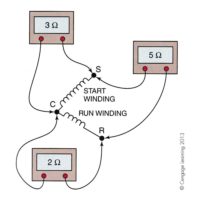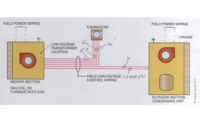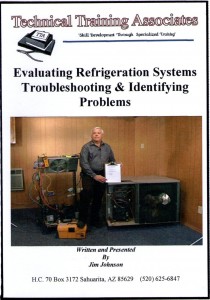Bob and Tim are at a customer’s house that has a gas furnace and electric air conditioning. The complaint is that the system is not working at all. They talked with the customer, who said, “Everything was running fine yesterday. We noticed late yesterday afternoon that the house was beginning to warm up. Since it is not very hot, it was not very noticeable. But, this morning we got up, and we noticed it was very warm and humid in the house.”
“We will go see what we can find,” Bob said. “Surely we can fix this in a very short period of time.”
They went to the room thermostat, and Bob suggested that Tim turn the fan switch to “fan on” to see if the fan would start. The fan did not start up, and Bob said, “This seems like we have a power failure in the low voltage circuit — when the fan won’t start, and the system won’t start, it indicates the voltage is off. Let’s go to the air handler, and see what’s going on there.”
They went to the air handler and removed the front door so that they could reach the low-voltage control circuit.
Bob then said to Tim, “Check the voltage from R to C, and see what you have.”
Tim said, “The R is the hot terminal and the C is the common terminal, and there is no voltage.”
“Check the small fuse at the transformer line going to the circuit board,” Bob replied. “Remove the fuse, and check it with the ohmmeter.”
Tim removed the fuse and checked it. “It is open circuit,” he said. “I guess we solved that one in a hurry. That was easy, you just had to know where to go and look. I will change the fuse, and we will be done here.”
“Not so fast,” Bob said. “What blew the fuse?”
“That’s a good question,” Tim replied. “I wish I had asked it instead of you.”
“Remove all of the wires going to the field wiring,” Bob instructed. “That includes the following five wires:
1. R wire or hot wire
2. C wire or common wire
3. G wire or the “fan on” wire
4. W wire or the heat wire
5. Y wire or the compressor wire
This way, we can isolate the circuits and try to figure out which circuit has the short that would blow the fuse. Now take the ohmmeter and, check the two wires going from the transformer to the circuit board to see if there is a resistance in those two wires.”
Tim said, “The circuit board has a high resistance in it, so there is a circuit in the board but not enough to blow a fuse, I don’t think.”
“Move to the field wiring that is connected, disconnect all of them, check the circuit from the red wire to the common wire, and see what the resistance is,” Bob said.
Tim checked it and then said, “There is very little resistance between these two wires — there seems to be a short from the hot wire to the common wire in the field circuit — what do we do next?”
“Let’s go to the room thermostat and remove all of the field wiring off of the thermostat,” Bob said.
When they had removed the wires from the room thermostat, Bob instructed Tim to check from the red wire to the common wire identify the resistance on this end of the field circuit wiring.
Tim checked the resistance from hot to common and said, “There seems to be a dead short on this end also. I think we have found that the problem is between the indoor unit and the thermostat in the field control wiring.”
The wire ran down through the wall and to the crawlspace below the house. The wall behind the thermostat was a utility room. They looked around and saw some new shelving had been installed, and Bob said, “Let’s go talk to the homeowner about this new shelving”.
They went up and talked to the homeowner, and he said he had installed the shelving yesterday afternoon.
Bob said, “I think you may have drilled into the control wiring in the wall with one of the long screws. Let’s unload the shelving and back the screw out where the control wiring was running down inside the wall and see what we see.”
They took the shelving down and backed the screw out of the bracket. They went back and checked the continuity across the hot to the common wire at the air handler, and Tim said, “The short has gone away. We have cured the problem.”
Bob then said, “If the screw just broke the insulation and touched the two wires together without breaking one of them, everything will be OK. If the system will still operate this way, we will just relocate the screw and bracket. This is a low-voltage circuit with a very low amperage fusing, so there is no danger in having a low-voltage wire that has just been nicked a little.
However, I am not comfortable doing that. Let’s look into pulling a new wiring harness. Go to the truck and get a roll of five-wire thermostat wire (Figure 1). We will use the five-wire harness to go from the thermostat to the air handler. We will see if we can attach the wire at the thermostat to the five wires on the role, making as small a connection as we can, and then we will see if we can pull that cable through the wall downward to where it comes out and goes to the air handler (Figure 2). If we can’t do that, we can bore a hole from where the wire comes through the wall to the thermostat straight into the utility room, and run the wire along the wall to the air handler. I would like to keep the wire in the wall, but if we can’t, we will have to run it externally.”
They were able to pull the wire through the wall and to the air handler where they connected it on both ends — one at the thermostat and one to the air handler.
They then checked all modes of operation with the thermostat, and everything operated correctly. They could operate in cooling, heating, and fan on. They felt like everything was good. They relocated the shelf bracket over about an inch where it did not touch the wire, and everything was still OK.
Publication date: 10/23/2017
Want more HVAC industry news and information? Join The NEWS on Facebook, Twitter, and LinkedIn today!












